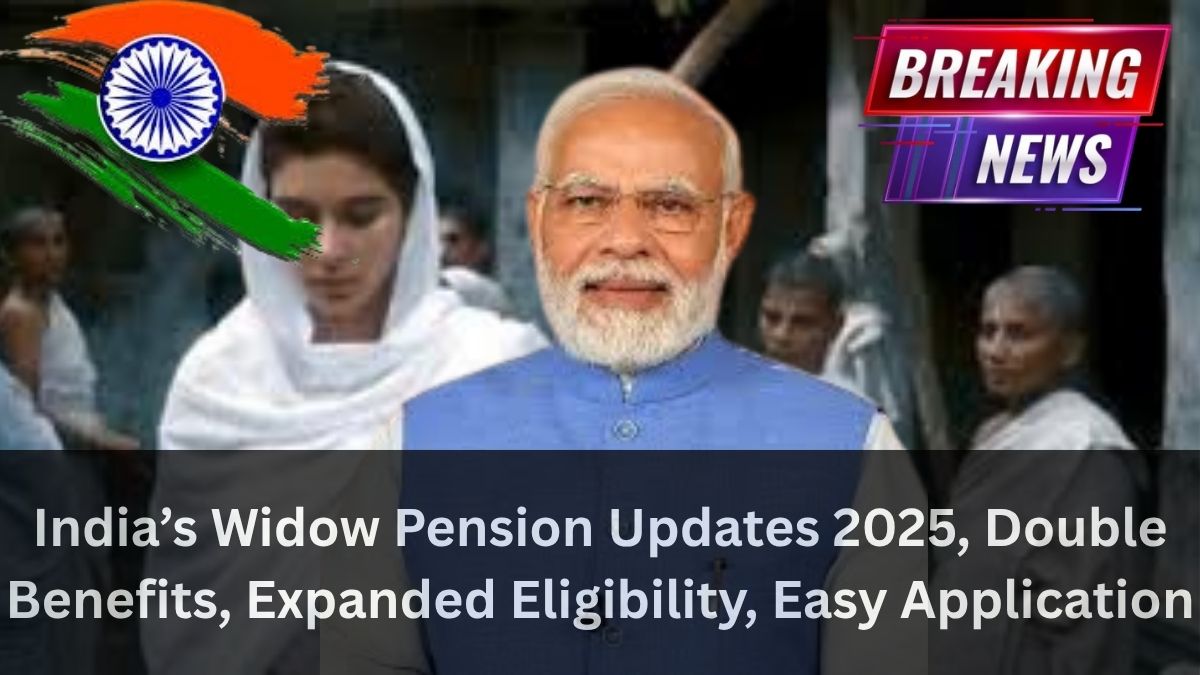In a landmark move, the Government of India has announced a major enhancement to the Widow Pension Scheme starting in 2025. Under this revised scheme, the monthly pension amount will be doubled, signaling a strong commitment to empowering widowed women across the country. This is one of the most substantial social welfare reforms in recent years and is expected to benefit millions of households.
The revised policy not only boosts financial support but also brings much-needed attention to the unique socio-economic challenges widows face in India—ranging from poverty and marginalization to limited job prospects and healthcare access.

Summary Table
| Key Element | Details |
|---|---|
| Initiative Name | Enhanced Widow Pension Scheme 2025 |
| Announcement Year | 2024 |
| Implementation Start | Early 2025 |
| Pension Benefit | Pension amount doubled |
| Age Requirement | Minimum 18 years |
| Income Eligibility | Annual household income below ₹1.5 lakh |
| Documents Required | Aadhaar card, spouse’s death certificate, bank account details |
| Application Modes | Online via government portal, offline support centers |
| Support Tools | Helpline numbers, digital tracking system |
| Official Website | https://www.india.gov.in |
Closer Look at the New Widow Pension Scheme
The new widow pension plan is part of a broader social security and welfare initiative aimed at creating a more inclusive safety net. For years, widows in India have relied on minimal pension support, often struggling to meet even the most basic living expenses.
By doubling the pension benefits, the government aims to:
-
Provide economic independence
-
Restore dignity and self-reliance
-
Address gender-specific vulnerabilities
-
Promote social inclusion and empowerment
This move is an acknowledgment of the hardships widows endure, and it seeks to provide them with a stable financial foundation so they can lead fuller, more secure lives.
Key Features of the Enhanced Pension Scheme
The 2025 scheme includes several vital upgrades beyond the increased pension payout:
1. Inclusive Eligibility Criteria
-
Minimum Age: 18 years
-
Income Cap: Household income must be under ₹1.5 lakh per annum
-
Residency: Applicants must be Indian citizens and permanent residents
-
Dependents: Number of dependents considered in the application
-
Special Provisions: Additional support for widows with disabilities
2. Simplified Documentation
Applicants are only required to submit:
-
Aadhaar card
-
Death certificate of the spouse
-
Proof of bank account
-
Income-related documents
This reduction in bureaucratic hurdles aims to make the scheme accessible to women from even the most underserved communities.
Application Process: Step-by-Step Guide
To ensure inclusivity, the government has simplified the application process and made it available through both online and offline channels.
Step 1: Document Collection
-
Aadhaar card
-
Spouse’s death certificate
-
Proof of bank account
-
Income certificate (if applicable)
Step 2: Online Application
Visit the official portal and fill out the online pension application form. Upload all required documents digitally.
Step 3: Offline Assistance
Support centers across the country offer in-person help for widows who may not have access to digital tools or are unfamiliar with online systems.
Step 4: Submission and Tracking
After submission, applicants will receive an SMS confirmation and can track the application status online through the government portal.
Anticipated Impact on Widows and Families
The revised pension scheme is expected to deliver a wide range of socio-economic benefits:
| Benefit Area | Expected Outcomes |
|---|---|
| Financial Security | Reduction in poverty; greater control over household finances |
| Healthcare Access | Ability to afford essential medical treatments and medications |
| Education | Improved schooling options for children of widows |
| Social Engagement | Increased participation in community and cultural events |
| Mental Well-being | Reduction in stress and anxiety due to financial instability |
The program also promotes social dignity, reducing the stigma often associated with widowhood in traditional communities.
Challenges and Government Responses
1. Timely Disbursement
Delays in fund transfers can undermine the scheme’s effectiveness. To counter this, the government will rely on Direct Benefit Transfers (DBT) and real-time tracking mechanisms.
2. Accessibility in Remote Areas
Outreach to widows in rural or tribal regions is a significant challenge. The government is addressing this via:
-
Mobile service units
-
Collaboration with NGOs and community organizations
3. Transparency and Accountability
Digitization of the application and distribution process using Aadhaar-based verification and bank transfers will minimize corruption and ensure that only eligible applicants benefit.
Looking Ahead: The Future of Widow Welfare in India
The 2025 Widow Pension Scheme is seen as a stepping stone for broader social reforms. Future initiatives may include:
-
Periodic increase in pension amounts
-
Inclusion of health insurance benefits
-
Access to vocational training for employability
-
Provision of housing and shelter for homeless widows
Regular reviews, feedback mechanisms, and policy adaptations will ensure the scheme remains dynamic and impactful.
FAQs on the 2025 Widow Pension Scheme
1. When will the new widow pension scheme start?
The enhanced scheme will begin implementation in early 2025.
2. How much pension will widows receive under the new scheme?
The exact amount varies by state, but the monthly pension will be doubled compared to the existing benefits.
3. Can young widows under 25 apply?
Yes, any widow 18 years or older is eligible, provided other conditions are met.
4. What documents are required to apply?
You will need an Aadhaar card, death certificate of your spouse, bank account details, and an income certificate.
5. Where can I apply online?
You can apply through the official portal: https://www.india.gov.in
6. Is offline application support available?
Yes, government-run support centers are available for offline applications, particularly in rural or underserved regions.
Conclusion
The enhancement of the widow pension scheme is more than a financial reform—it is a social revolution that uplifts millions of marginalized women. With proper iamplementation and continuous monitoring, this program can dramatically transform the quality of life for widows in India.
The 2025 initiative stands as a powerful reminder that policy, when done right, can restore hope, dignity, and independence to the lives of those who need it most.
Click here to know more



